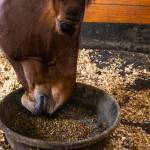Equine Hair Analysis

Fast forward two years, four years, maybe ten. You’ve found the perfect horse, the quintessential equine companion-an affable, athletic, and handsome gelding. The prepurchase exam, that requisite though nerve-racking precarious last step prior to closing the deal, is almost complete.
Just as you hoped, the gelding has breezed through the battery of usual inconveniences—flexion tests, radiographs, farrier consults. Only the results of one test are standing in the way of you and your dream mount, those of the hair analysis. While the suggestion of hair analysis as a routine prepurchase procedure may be a smidgen far-fetched, in this day and age, where millions of dollars exchange hands for race and show horses alike, nothing is too over-the-top. As advances in hair analysis march forward, could potential buyers one day be able to chronicle certain aspects of a horse’s life, including its medication history and perhaps even its nutritional status, by simply having its hair scrutinized? Maybe, maybe not.
The Basics
Hair often does not get its due from horsemen. In fact, some gripe and grumble about the work the natural hair growth of their charges causes them. Much time is spent primping horses for appearances—pulling manes, clipping ears and bridlepaths, and polishing coats—but horses have hair for a number of reasons, least of which is sheer vanity.
First and foremost, hair helps in the formidable task of bodywide temperature regulation, and one integral aspect of this role is providing a shield against environmental conditions, hence the dense, wooly coats of winter and the slick, short coats of summer. Other functions of hair include protection against predatory insects and a pathway for transport of pheromones and other physiological signals from the body. Horses possess three primary hair types: temporary, permanent, and tactile. Temporary hair covers the majority of the body, and horses shed this hair seasonally, once in the spring and once in the fall. Permanent hair includes the eyelashes, forelock, mane, tail, and feathers, the long hair that adorns the lower legs of many draft-type horses. The anatomical position of permanent hair also furnishes a degree of defense. When long enough, for example, the mane insulates the major blood-carrying vessels to the brain, and eyelashes guard against eye injuries. Tactile hair includes that which grows on the muzzle and in the ears.
Of these three types, permanent hair, principally mane and tail, is used most often in analysis. Mane is preferred because of its finer texture and manageability, for it is usually shorter than strands of the tail. Hair from the mane is also less prone to contamination from urine, feces, and bedding. Perhaps most importantly, results from routine hair testing are more consistent when mane is used.
Assessment of Nutritional Status
Permanent hair is a potentially useful tissue for trace mineral analysis because it is easily harvested and transported, contains a high concentration of trace elements, and may be representative of nutritional status over an extended period of time. In the past two decades, advances in laboratory methods have made analysis possible for multiple elements, and refinement in analytical procedures has resulted in comparatively inexpensive techniques. Hair analysis is beneficial only if it accurately and consistently reflects nutritional imbalances, however, and this seems to be a stumbling block for some nutritionists who are not wholly convinced of the validity of hair analysis.
Without a doubt, hair analysis has been integral in determining exposure to heavy metals and other environmental toxins. In one instance, horses in central Europe were exposed to cadmium, a toxic metallic element, and traces of the substance were found in tail samples from horses of all ages, genders, and breeds. Interestingly, traces accumulated to a greater extent in the hair of geldings. In a study conducted in the mid-1990s, researchers examined the buildup of toxic heavy metals and elements in horses and other animals exposed to vehicle emissions. Abnormally high levels of lead and cadmium were found in horse hair samples. Lead concentrations were similar in hair and blood, lending credence to hair analysis as an effective measure of toxicity.
Similarly, selenium, an essential micronutrient in the diets of horses, can also be detected in hair. Harold Hintz, Ph.D., a professor of animal nutrition at Cornell University, said, “Hair analysis may be useful in identifying horses being fed high-selenium diets, those in the toxic range.
Although Hintz has been investigating the possibility of hair analysis as a means of evaluating nutritional adequacy of trace minerals on and off for over 20 years, he questions the merit of the testing for the majority of minerals. “As a routine procedure, it’s not generally accurate.” Veterinarian and nutritionist Sarah Ralston shares the sentiments of Hintz. Ralston, a faculty member at RutgersUniversity, agrees that hair analysis may be “vaguely useful” for selenium status, but believes values from blood samples are more representative of true levels. In terms of other minerals, Ralston cited one study in which horses were fed escalating amounts of calcium. The calcium content of hair samples, however, did not correspond with increasing blood levels, once again suggesting the questionable merit of the procedure.
Determining Drug Administration History
While hair analysis may be a dubious method to ascertain the nutritional state of a horse, the notion of using it to establish pharmaceutical history is a burgeoning field of scientific study. Mark Dunnett, Ph.D., a research associate with The Royal Veterinary College at the University of London, recently completed research that examined the accumulation of therapeutic and illicit drugs in mane and tail hair. As part of this study, he also evaluated the potential of hair analysis for the retrospective detection of drug use and misuse in horses. Results indicated that common antibiotic preparations such as sulphonamides trimethoprim, and metronidazole could be detected in mane and tail hair for up to two years following systemic administration. Methylxanthine drugs and their metabolites have been routinely identified in mane and tail hair. Caffeine and theobromine are the most well-known methylxanthines. These drugs are usually regarded as prohibited substances in equine competition because of their diuretic properties and central nervous system and cardiac stimulatory effects.
Another drug in the same family, etamiphylline, was the subject of inquiry by Dunnett and co-workers. Etamiphylline is a bronchodilator often used in the treatment of chronic obstructive pulmonary disease. This study was staged to determine if hair could be used to differentiate between acute and sustained etamiphylline dosing. The drug was administered orally to five ponies— three blacks, one chestnut, and one gray—for eight days.
Once drug administration ended, researchers collected approximately 30 strands of hair from the midpoint of the mane. Hair was then sliced into minute sections before analysis. Blood samples were also collected at the time of hair harvesting to determine circulating levels of the medication. Interestingly, hair from the black ponies contained traces of etamiphylline as early as 24 hours after administration ended, but no evidence was found in the hair of the chestnut or gray ponies. Why the disparity? Dunnett explained, “The drug binds to melanin, a pigment abundant in dark-colored hair. Chestnut, gray, or white hair contains little or no melanin, so the drug has nothing to attach to.” Perhaps the most useful application of hair analysis is the assurance of a level playing field during competitive equine events. Countless performance-enhancing drugs, including stimulants and sedatives, have been misused over the years. Unfortunately, the abuse does not necessarily commence when performance horses begin training.
Growth promotants such as the anabolic steroids stanozolol and boldenone, both derivatives of the male hormone testosterone, are abused in horses being prepared for sales, show ring competitions, and racing where above average musculature is prized. “There is no legitimate reason for sustained use of anabolic drugs in young horses, including two-year-olds in race training,” said Dunnett. In older horses, anabolic steroids are often resorted to in a last-ditch effort to improve down-spiraling performance. In a recent French study, horses were given an intramuscular injection of either stanozolol or boldenone. Hair from these horses was then compared to hair from untreated horses. Both anabolic agents were discovered in the samples obtained from the treated horses.
Other drugs purported to increase performance, such as morphine, diazepam (a sedative), and clenbuterol (a bronchodilator), have been identified in equine hair. Scientists have met with less success in measuring other well-known drugs in hair. In a study conducted three years ago, cocaine was not detected in mane samples following intravenous or oral administration. However, procaine, a drug commonly used as a local anesthetic, was readily detected in hair, according to Dunnett. Hair analysis may be especially useful in determining whether drug administration was acute or chronic.
Racehorses often fail post-race tests for prohibited substances because of chronic feed contamination. Examples of documented feedstuff contaminants include arsenic, atropine, caffeine, morphine, and theobromine, among a host of others. If a trainer maintains that no performance enhancing agent was given and the results of hair analysis validate the assumption of feed impurity and long-term exposure, horsemen may be able to dodge fines and suspensions or at least lessen the harshness of those imposed. “Hair analysis may be used as supportive evidence to back up findings of routine blood and urine tests,” said Dunnett, who has been called as an expert witness in the United States, “but it’s not applicable to race-day testing, obviously because of the slow nature of hair growth.”
Advances in horse hair analysis have unveiled an abundance of untouched research possibilities. As science moves forward, the likelihood that hair will reveal further information about the health and well-being of horses is almost certain. So, before wielding those scissors or that pulling comb in an attempt to tame the locks of horses and ponies, just remember that with every severed or pulled hair, a piece of history may be lost forever.








